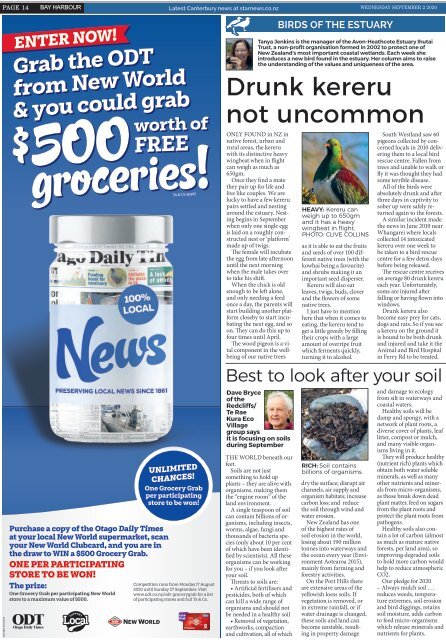Bay Harbour: September 02, 2020
You also want an ePaper? Increase the reach of your titles
YUMPU automatically turns print PDFs into web optimized ePapers that Google loves.
PAGE 14 Wednesday <strong>September</strong> 2 2<strong>02</strong>0<br />
BAY HARBOUR<br />
Latest Canterbury news at starnews.co.nz<br />
BIRDS OF THE ESTUARY<br />
Tanya Jenkins is the manager of the Avon-Heathcote Estuary Ihutai<br />
Trust, a non-profit organisation formed in 20<strong>02</strong> to protect one of<br />
New Zealand’s most important coastal wetlands. Each week she<br />
introduces a new bird found in the estuary. Her column aims to raise<br />
the understanding of the values and uniqueness of the area.<br />
Drunk kereru<br />
not uncommon<br />
ONLY FOUND in NZ in<br />
native forest, urban and<br />
rural areas, the kereru<br />
with its distinctive heavy<br />
wingbeat when in flight<br />
can weigh as much as<br />
650gm.<br />
Once they find a mate<br />
they pair up for life and<br />
live like couples. We are<br />
lucky to have a few kereru<br />
pairs settled and nesting<br />
around the estuary. Nesting<br />
begins in <strong>September</strong><br />
when only one single egg<br />
is laid on a roughly constructed<br />
nest or ‘platform’<br />
made up of twigs.<br />
The female will incubate<br />
the egg from late afternoon<br />
until the next morning<br />
when the male takes over<br />
to take his shift.<br />
When the chick is old<br />
enough to be left alone,<br />
and only needing a feed<br />
once a day, the parents will<br />
start building another platform<br />
closeby to start incubating<br />
the next egg, and so<br />
on. They can do this up to<br />
four times until April.<br />
The wood pigeon is a vital<br />
component in the wellbeing<br />
of our native trees<br />
Dave Bryce<br />
of the<br />
Redcliffs/<br />
Te Rae<br />
Kura Eco<br />
Village<br />
group says<br />
it is focusing on soils<br />
during <strong>September</strong><br />
THE WORLD beneath our<br />
feet.<br />
Soils are not just<br />
something to hold up<br />
plants – they are alive with<br />
organisms, making them<br />
the “engine room” of the<br />
land environment.<br />
A single teaspoon of soil<br />
can contain billions of organisms,<br />
including insects,<br />
worms, algae, fungi and<br />
thousands of bacteria species<br />
(only about 10 per cent<br />
of which have been identified<br />
by scientists). All these<br />
organisms can be working<br />
for you – if you look after<br />
your soil.<br />
Threats to soils are:<br />
• Artificial fertilisers and<br />
pesticides, both of which<br />
can kill a wide range of<br />
organisms and should not<br />
be needed in a healthy soil<br />
• Removal of vegetation,<br />
earthworks, compaction<br />
and cultivation, all of which<br />
HEAVY: Kereru can<br />
weigh up to 650gm<br />
and it has a heavy<br />
wingbeat in flight.<br />
PHOTO: CLIVE COLLINS<br />
as it is able to eat the fruits<br />
and seeds of over 100 different<br />
native trees (with the<br />
kowhai being a favourite)<br />
and shrubs making it an<br />
important seed disperser.<br />
Kereru will also eat<br />
leaves, twigs, buds, clover<br />
and the flowers of some<br />
native trees.<br />
I just have to mention<br />
here that when it comes to<br />
eating, the kereru tend to<br />
get a little greedy by filling<br />
their crops with a large<br />
amount of overripe fruit<br />
which ferments quickly,<br />
turning it to alcohol.<br />
dry the surface; disrupt air<br />
channels, air supply and<br />
organism habitats; increase<br />
carbon loss; and reduce<br />
the soil through wind and<br />
water erosion.<br />
New Zealand has one<br />
of the highest rates of<br />
soil erosion in the world,<br />
losing about 190 million<br />
tonnes into waterways and<br />
the ocean every year (Environment<br />
Aotearoa 2015),<br />
mainly from farming and<br />
forestry activities.<br />
On the Port Hills there<br />
are extensive areas of the<br />
yellowish loess soils. If<br />
vegetation is removed, or<br />
in extreme rainfall, or if<br />
water drainage is changed,<br />
these soils and land can<br />
become unstable, resulting<br />
in property damage<br />
South Westland saw 60<br />
pigeons collected by concerned<br />
locals in 2010 delivering<br />
them to a local bird<br />
rescue centre. Fallen from<br />
trees and unable to walk or<br />
fly it was thought they had<br />
some terrible disease.<br />
All of the birds were<br />
absolutely drunk and after<br />
three days in captivity to<br />
sober up were safely returned<br />
again to the forests.<br />
A similar incident made<br />
the news in June 2019 near<br />
Whangarei where locals<br />
collected 14 intoxicated<br />
kereru over one week to<br />
be taken to a bird rescue<br />
centre for a few detox days<br />
before being released.<br />
The rescue centre receives<br />
on average 80 drunk kereru<br />
each year. Unfortunately,<br />
some are injured after<br />
falling or having flown into<br />
windows.<br />
Drunk kereru also<br />
become easy prey for cats,<br />
dogs and rats. So if you see<br />
a kereru on the ground it<br />
is bound to be both drunk<br />
and injured and take it the<br />
Animal and Bird Hospital<br />
in Ferry Rd to be treated.<br />
Best to look after your soil<br />
RICH: Soil contains<br />
billions of organisms.<br />
and damage to ecology<br />
from silt in waterways and<br />
coastal waters.<br />
Healthy soils will be<br />
damp and spongy, with a<br />
network of plant roots, a<br />
diverse cover of plants, leaf<br />
litter, compost or mulch,<br />
and many visible organisms<br />
living in it.<br />
They will produce healthy<br />
(nutrient rich) plants which<br />
obtain both water soluble<br />
minerals, as well as many<br />
other nutrients and minerals<br />
from micro-organisms,<br />
as those break down dead<br />
plant matter, feed on sugars<br />
from the plant roots and<br />
protect the plant roots from<br />
pathogens.<br />
Healthy soils also contain<br />
a lot of carbon (almost<br />
as much as mature native<br />
forests, per land area), so<br />
improving degraded soils<br />
to hold more carbon would<br />
help to reduce atmospheric<br />
CO2.<br />
Our pledge for 2<strong>02</strong>0<br />
– Always mulch soil . . .<br />
reduces weeds, temperature<br />
extremes, soil erosion<br />
and bird diggings, retains<br />
soil moisture, adds carbon<br />
to feed micro-organisms<br />
which release minerals and<br />
nutrients for plants.


















